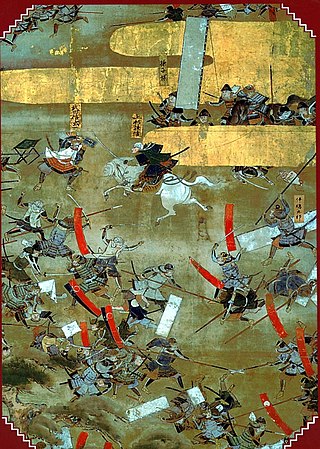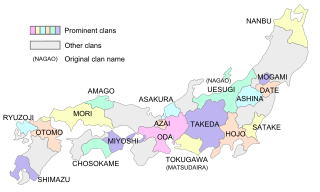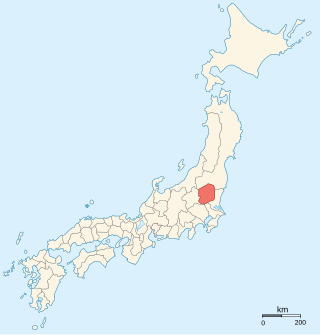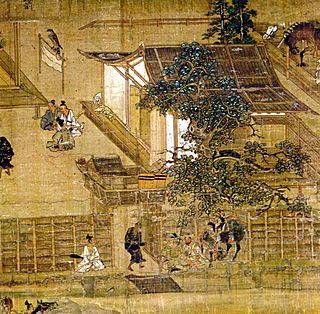| Part of a series on the |
| History of Japan |
|---|
 |
This is the glossary of Japanese history including the major terms, titles and events the casual (or brand-new) reader might find useful in understanding articles on the subject.
| Part of a series on the |
| History of Japan |
|---|
 |
This is the glossary of Japanese history including the major terms, titles and events the casual (or brand-new) reader might find useful in understanding articles on the subject.

Edo, also romanized as Jedo, Yedo or Yeddo, is the former name of Tokyo.

Shogun, officially sei-i taishōgun, was the title of the military rulers of Japan during most of the period spanning from 1185 to 1868. Nominally appointed by the Emperor, shoguns were usually the de facto rulers of the country. Although during part of the Kamakura period and Sengoku period, shoguns were figureheads themselves, with real power in the hands of the shikken (執権) of the Hōjō clan and kanrei (管領) of the Hosokawa clan. In addition, Taira no Kiyomori and Toyotomi Hideyoshi were leaders of the warrior class who did not hold the position of shogun, the highest office of the warrior class, yet gained the positions of daijō-daijin and kampaku, the highest offices of the aristocratic class. As such, they ran their governments as its de facto rulers.
The Kamakura shogunate was the feudal military government of Japan during the Kamakura period from 1185 to 1333.

The Ashikaga shogunate, also known as the Muromachi shogunate, was the feudal military government of Japan during the Muromachi period from 1336 to 1573.

The Sengoku period, also known as Sengoku Jidai is the period in Japanese history in which civil wars and social upheavals took place almost continuously in the 15th and 16th centuries. Although the Kyōtoku incident (1454), Ōnin War (1467) or Meiō incident (1493) is generally chosen as the Sengoku period's start date, there are many competing historiographies for its end date, ranging from 1568, the date of Oda Nobunaga's march on Kyoto, to the suppression of the Shimabara Rebellion in 1638, deep into what is traditionally considered the Edo period. Regardless of the dates chosen, the Sengoku period overlaps substantially with the Muromachi period (1336–1573).

Daimyo were powerful Japanese magnates, feudal lords who, from the 10th century to the early Meiji period in the middle 19th century, ruled most of Japan from their vast, hereditary land holdings. They were subordinate to the shogun and nominally to the emperor and the kuge. In the term, dai (大) means 'large', and myō stands for myōden (名田), meaning 'private land'.

Shimotsuke Province was a province of Japan in the area of Japan that is today Tochigi Prefecture. Shimotsuke was bordered by Kōzuke, Hitachi, Mutsu and Shimōsa Provinces. Its abbreviated form name was Yashū (野州). Under the Engishiki classification system, Shimotsuke was ranked as one of the 13 "great countries" (大国) in terms of importance, and one of the 30 "far countries" (遠国) in terms of distance from the capital. The provincial capital is located in what is now the city of Tochigi. The Ichinomiya of the province is the Futarasan jinja located in what is now the city of Utsunomiya.

The Oda clan is a Japanese samurai family who were daimyo and an important political force in the unification of Japan in the mid-16th century. Though they had the climax of their fame under Oda Nobunaga and fell from the spotlight soon after, several branches of the family continued as daimyo houses until the Meiji Restoration. After the Meiji Restoration, all four houses of the clan were appointed Viscount in the new system of hereditary peerage.

Wakasa Province was a province of Japan in the area that is today the southwestern portion of Fukui Prefecture in the Hokuriku region of Japan. Wakasa bordered on Echizen, Ōmi, Tanba, Tango, and Yamashiro Provinces. It was part of Hokurikudō Circuit. Its abbreviated form name was Jakushū (若州). Under the Engishiki classification system, Wakasa was ranked as a "medium country" (中国) and a near country (近国) in terms of its importance and distance from the capital.

A gokenin (御家人) was initially a vassal of the shogunate of the Kamakura and the Muromachi periods. In exchange for protection and the right to become jitō, a gokenin had in times of peace the duty to protect the imperial court and Kamakura. In times of war, he had to fight with his forces under the shōgun’s flag. From the mid-13th century, the fact that gokenin were allowed to become de facto owners of the land they administered, coupled to the custom that all gokenin children could inherit, brought the parcelization of the land and a consequent weakening of the shogunate. The gokenin class ceased to be a significant force during the Muromachi period and was supplanted by the figure of the daimyō. During the successive Edo period, the term finally came to indicate a direct vassal of the shōgun, below an omemie (御目見), meaning that they did not have the right to an audience with the shōgun.

The Takeda Clan was a Japanese samurai clan active from the late Heian period until the late 16th century. The clan was historically based in Kai Province in present-day Yamanashi Prefecture. The clan reached its greatest influence under the rule of Takeda Shingen, one of the most famous rulers of the period.

The Uesugi clan is a Japanese samurai clan which was at its peak one of the most powerful during the Muromachi and Sengoku periods. At its height, the clan had three main branches: the Ōgigayatsu, Inukake, and Yamanouchi. Its most well-known member is the warlord Uesugi Kenshin (1530–1578).
Uesugi is a Japanese surname. Notable people with the surname include:

Tozama daimyō was a class of powerful magnates or daimyō (大名) considered to be outsiders by the ruler of Japan during the Edo period (江戸時代). Tozama daimyō were classified in the Tokugawa shogunate (江戸幕府) as daimyō who became hereditary vassals of the Tokugawa after the Battle of Sekigahara (関ヶ原の戦い). Tozama daimyō were discriminated against by the Tokugawa and opposed to the fudai daimyō, who were allies or vassals of Tokugawa before Sekigahara.

The Satake clan was a Japanese samurai clan that claimed descent from the Minamoto clan. Its first power base was in Hitachi Province. The clan was subdued by Minamoto no Yoritomo in the late 12th century, but later entered Yoritomo's service as vassals. In the Muromachi period, the Satake served as Governor (shugo) of Hitachi Province, under the aegis of the Ashikaga shogunate. The clan sided with the Western Army during the Battle of Sekigahara, and was punished by Tokugawa Ieyasu, who moved it to a smaller territory in northern Dewa Province at the start of the Edo period. The Satake survived as lords (daimyō) of the Kubota Domain. Over the course of the Edo period, two major branches of the Satake clan were established, one ruled the fief of Iwasaki, the other one the fief of Kubota-Shinden.

The Satomi clan was a Japanese samurai clan of the Sengoku period (1467–1573) and early Edo period (1603–1868). The clan ruled Awa Province as a Sengoku daimyō and was a major military power in the Kantō region during the wars of the Nanboku-chō period. Although confirmed as daimyō of Tateyama Domain by the Tokugawa shogunate.

Takasaki Domain was a feudal domain under the Tokugawa shogunate of Edo period Japan, located in Kōzuke Province, Japan. It was centered on Takasaki Castle in what is now part of the city of Takasaki, Gunma. Takasaki was ruled through most of its history by a junior branch of the Matsudaira clan.

Ashikaga Domain was a feudal domain under the Tokugawa shogunate of Edo period Japan, located in Shimotsuke Province, Japan. It was centered on Ashikaga jin'ya in what is now part of the city of Ashikaga. Ashikaga was ruled through most of its history by a junior branch of the Toda clan.
Sano Domain was a feudal domain under the Tokugawa shogunate of Edo period Japan, located in Shimotsuke Province, Japan. It was centered in what is now part of the city of Sano, Tochigi. Sano was ruled through most of its history by a junior branch of the Hotta clan.

Koga Castle was a Japanese castle located in Koga, Ibaraki Prefecture, Japan. During the Muromachi period, Koga was the seat of the Kantō kubō, under the Ashikaga clan. At the end of the Edo period, Koga Castle was the administrative center of Koga Domain, which was held by a large number of fudai daimyō clans, spending the longest time under the control of the Doi clan.